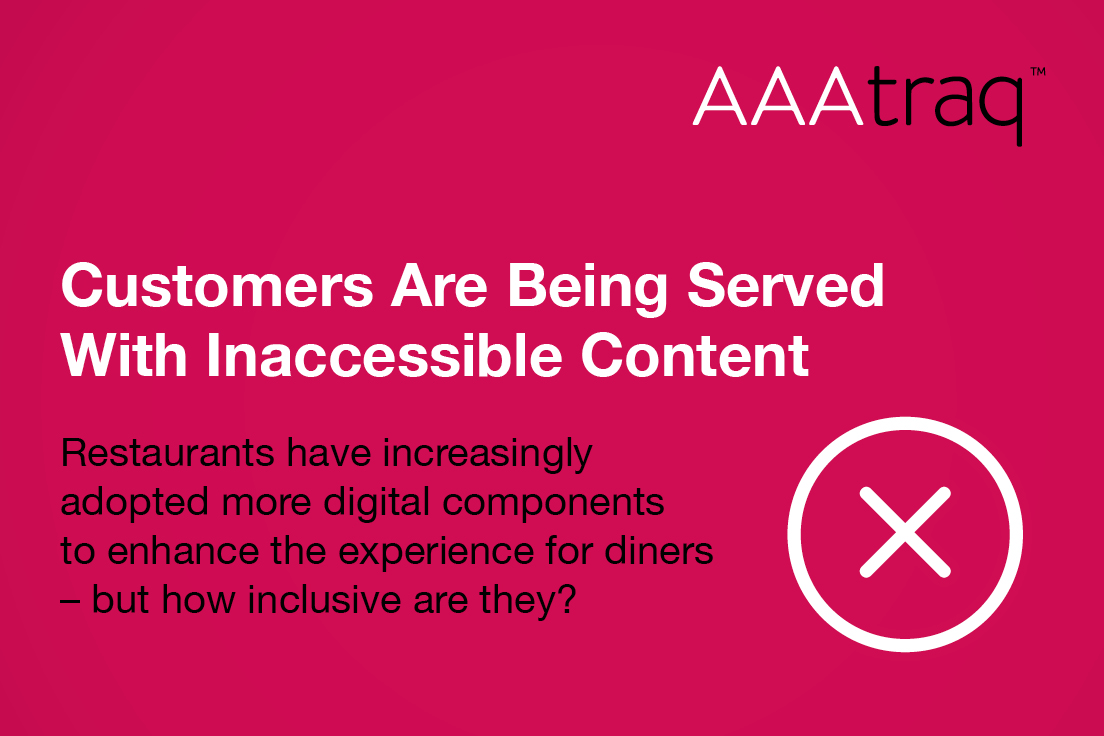Customers Are Being Served With Inaccessible Content
Jul 19 2022
Three years after the onset of the COVID-19 Pandemic, very few things are certain beyond the fact that life has forever been changed. Of the many adaptations to everyday life, one change that appears to be of a more permanent nature is the predilection to more flexibility in dining.
Throughout the past two years, restaurants have transitioned to more flexible dining options and have begun to use technology to assist in the dining process. In using technology in the dining process, some restaurants were able to eliminate some of the human interaction component which was (and remains) a cause for concern because of the Pandemic. Technologies have been incorporated into the dining process such as the use of contactless dining through mobile ordering, check payment, and kiosk ordering. These elements enable diners to engage with the dining process in more casual, safe, and (oftentimes) inclusive ways. These features, whilst making facets of the restaurant process more inclusive to some diners, can alienate others, namely those with disabilities. Individuals with disabilities face several obstacles to engaging with these new technologies, and thus have been discriminated against in a manner that is in direct opposition to the sentiments under which the Americans with Disabilities Act (ADA) was written.
How is this technology used?
Diners, restaurant owners, and staff have increasingly adopted more digital components to their experiences. These new forms of technology have been utilized in the dining process to accomplish many things. For owners, the incorporation of more digital aspects into their experience can cut down on costs, increase revenue, and allow them to have real-time analytics into the performance of their restaurant. For staff, the adoption of technologies into the service process increases table turnover, could yield greater tips, and cuts down on the face-to-face time with the customer (which remains a risk due to COVID). For customers, the adoption of technologies into their dining experience allows for more control over the speed and interactive components of the dining experience. The inclusion of such technology allows able-bodied individuals the opportunity to engage with their service, while further alienating disabled customer when not programmed in the most inclusive fashion.
The addition of such technology doesn’t inherently mean that your restaurant is becoming more inaccessible to disabled diners. Technology, when coded and used appropriately, could have a positive impact on the dining experience of all customers, including the disabled. It is when features are improperly coded, and/or the accessibility aspects of the technology are neglected, that disabled diners are unjustly discriminated against in the dining experience. Features such as QR codes, menus, and check payment require significant attention in the set-up process to make their use accessible. These features have the potential to discriminate against the physically and visually impaired. Restaurants, even prior to the Pandemic, began experimenting with in-restaurant mobile ordering and payment systems. These trials have shed light on major design flaws that can be grounds for litigious action. Still, when properly addressed, the use of technologies in dining can be mutually beneficial for all parties.
How to ensure inclusivity
Many of the barriers to inclusivity imposed by the addition of technology in restaurants are easily identifiable and can be addressed when the proper care is taken. As mentioned in a previous AAAtraq article, mobile ordering platforms need to take special care in ensuring that all links are properly labeled, all menu items are appropriate labeled, and that any alt-text is made readily available to users with screen-reader technology. In-restaurant mobile ordering, kiosk systems, and cash payment systems tend to feature failures in other areas as well, including unlabeled form fields, inaccessible third-party content (many restaurants have chosen to include some social media component that isn’t always accessible), and unusable speech-to-text functions.
Your website, like your restaurant should be inclusive. Start by understanding your level of exposure associated with your website – you can do it, free at https://AAAtraq.com/check/ (opens in a new window). No registration is required - and results are immediately available and understandable. Green = good - red = bad).
1 “Are Take Outs Being Taken out of Disabled Users Reach?,” AAAtraq, February 3, 2022, https://AAAtraq.com/news/2022/02/are-take-outs-being-taken-out-disabled-users-reach (opens in a new window).
Subscribe to AAAtraq and enjoy complete cover and peace of mind
